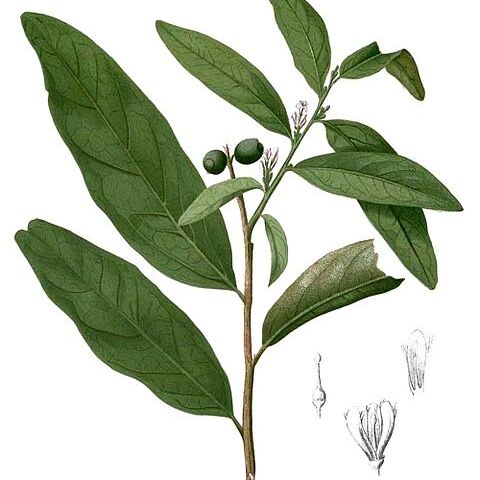Shrubs or small trees, often malodorous. Branchlets slightly flexuose. Leaves distichous, usually soft when fresh, yellow-green or pale grey-green, often undulate when dried; midrib evident; lateral nerves obscure. Flowers bisexual or unisexual, solitary (in Australian species), axillary, shortly pedicellate. Hypanthium present. Calyx short, cupular, entire or slightly lobed. Petals 5, connate but usually easily parted, each with small uncinate thickening inside at apex, creamy white or pale yellow, caducous. Stamens 3, inserted in corolla tube between lobes; staminodes 5, inserted ±opposite lobes; anthers 2-locular, introrse. Ovary partly immersed in hypanthium, 1-locular or imperfectly 3-locular, with 1 ovule per locule; style short, often caducous; stigma 3-lobed. Fruit with succulent exocarp formed by enlarged hypanthium; calyx persistent as apical collar. Seed 1.
Small trees or shrubs; branchlets usually slightly ridged, glabrous to poorly scabrid. Leaves alternate, distichous, simple and entire. Flowers solitary or racemose, bisexual; racemes with single flowers or fascicles; peduncle simple, rarely branched; pedicels articulate at their base. Calyx cupuliform, varying from accrescent to non-accrescent, ± undulate at the margin. Petals 3 or 5(–6), free, valvate, linear-spathulate, glabrous on the inner surface, apiculate. Stamens 3–6; staminodes 3–6; filaments ± adnate to the petals; sterile anthers filiform, usually longer than the fertile members. Ovary superior, tripartite at the base, borne on a circular disk; ovules 1 per locule, pendulous; style relatively short; stigma capitate (1–)3–4-lobed. Fruit a drupe, globose, often nearly enclosed by the accrescent calyx.
Trees or shrubs, sometimes climbers. Branchlets unarmed. Leaves alternate; leaf blade pinnately veined. Inflorescences racemelike or spikelike, sometimes paniculate; rachis ± zigzagged before anthesis. Calyx cupular, truncate or obscurely dentate, greatly accrescent in fruit. Petals 3, margin entire or deeply 2-lobed, free or connate at base. Stamens 3, basally adnate to petals; filaments flat; anthers oblong; staminodes 5, 2-cleft. Disk annular. Ovary superior, 3-loculed below, 1-loculed above, placenta central, free; ovules 3. Style short or elongate; stigma capitellate, minutely 3-lobed. Drupe ellipsoid to ± globose, basal 1/2 to near apex covered by persistent calyx, 1-seeded; endosperm copious.
Ovary superior, lageniform or conical, usually 3-locular at the base; ovules usually 3, pendulous from the apex of a central placenta; style included; stigma capitate, sometimes 3–4-lobed.
Stamens 3–6; staminodes 3–6; filaments ± attached to the corolla; sterile anthers filiform, usually bifid and longer than the fertile ones.
Flowers solitary and axillary, or in axillary solitary or fasciculate racemes; pedicels articulate at the base; buds oblong.
Shrubs or small trees up to 6 (12) m. tall; young branches yellowish-green, rugulose or scabridulous, narrowly 4-winged.
Petals 5 (6) or 3, valvate, connate in the bud, later free, recurved-apiculate inside at the top.
Calyx short, entire, cupuliform, undulate and/or inconspicuously denticulate at the margin.
Fruit drupaceous, glabrous, sometimes enclosed nearly to the apex by the accrescent calyx.
Seed with a minute apical embryo surrounded by fleshy endosperm.
Leaves distichous.
Disk circular.

